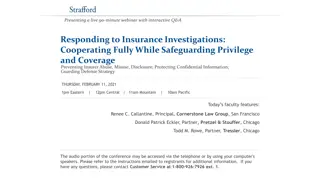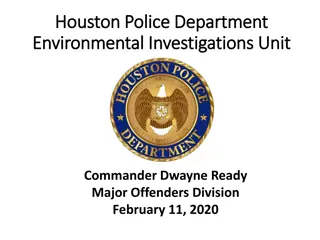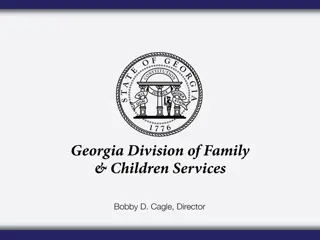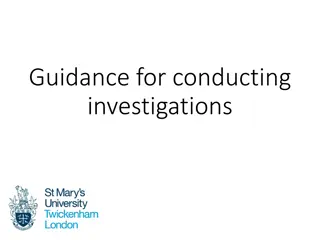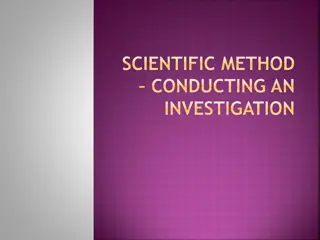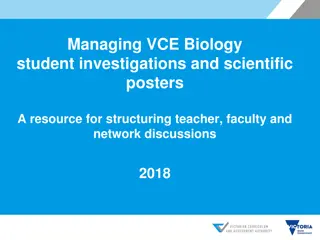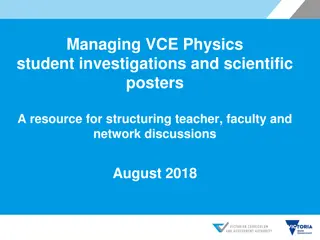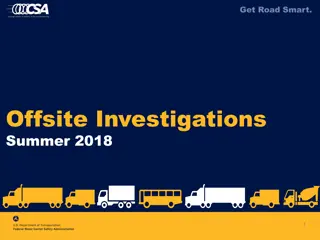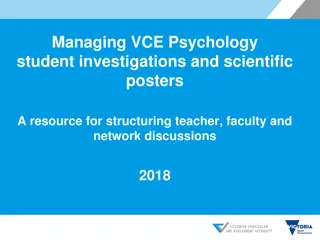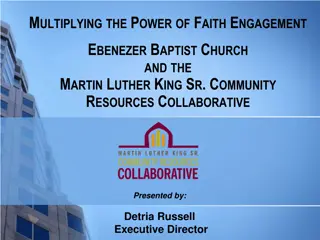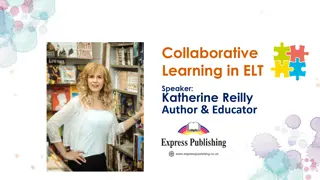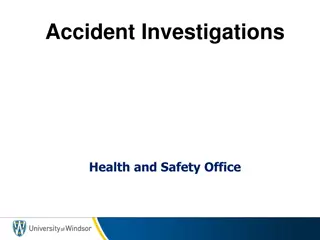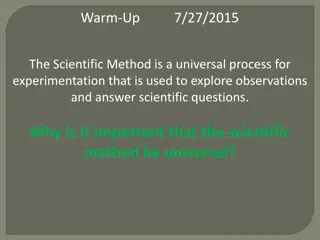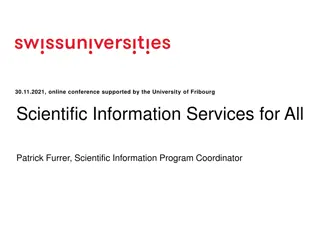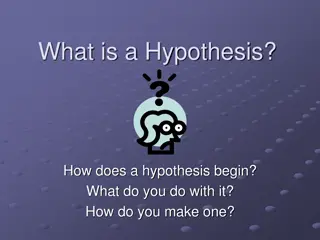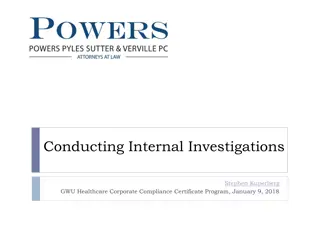Understanding Collaborative Research in Scientific Investigations
Collaborations in research play a pivotal role in achieving common goals and producing valuable outcomes. This module explores the nature of collaborative research, the importance of written agreements, examples of collaboration types, and the essential aspects of successful collaborative relationships. Communication, preparation, and clear delineation of roles and responsibilities are crucial for effective collaborations in scientific investigations.
- Collaborative Research
- Scientific Investigations
- Collaboration Types
- Written Agreements
- Research Integrity
Download Presentation

Please find below an Image/Link to download the presentation.
The content on the website is provided AS IS for your information and personal use only. It may not be sold, licensed, or shared on other websites without obtaining consent from the author. Download presentation by click this link. If you encounter any issues during the download, it is possible that the publisher has removed the file from their server.
E N D
Presentation Transcript
Collaboration Information for this module came from the Office of Research Integrity (ORI) website https://ori.hhs.gov/content/Chapter-8-Collaborative-Research-Introduction
Overview Collaborations are the nature of research and scientific investigations. Collaborations are joint efforts towards a common goal in order to create or produce something. 2
Objectives Participants will be able to Describe collaboration Give examples of various types of collaboration Determine when a written agreement is needed and what questions need to be answered in such an agreement 3
Collaboration is thought to mean a joint working relationship among individuals who are pursuing mutually interesting and beneficial research. Collaboration can include researchers of differing stature, funding status and types of organizations. Frequently, collaborations include post- doctoral fellows, research staff members, graduate and undergraduate students. 4
Members of two research groups in different departments of the same institution work together on a project. No external funding is involved, and the work is divided reasonably equally between the two groups. All those involved meet together regularly to review their progress and plan for publication of their results. In order to complete data collection for a large dataset (which a senior researcher has received federal funding), the researcher has organized a collaboration with three junior faculty members at other institutions who were previously his graduate students. Needing an analysis of the effect of a new compound on living plants, a researcher who is only familiar with laboratory analyses contacts an agricultural researcher she met at a conference. They agree to each carry out their own analysis of the new compound, and then combine their results for publication. To gain a more global perspective on a public health question, a collaboration among ten research groups in six countries is established. All research groups independently apply for their own funding. The collaborators agree that all data collected regarding the question they are studying will be made available to the entire collaborative. 5
Collaborative relationships require communication and preparation in order to avoid potential problems. Discussion items include the roles and responsibilities of each party, and the conduct of each party prior to, during and following the study. 6
There is a wide range of issues on which collaboration can falter. Collaborators can be in dispute over issues of access, sharing, management, and analysis of data; the use and sharing of biological materials; and even the scope and direction of the research project. There can also be disputes involving the collaborative relationship itself for example: - Sharing research space - Structure and function of research team meetings - Decisions about staffing needs of the project - Personal and scientific conflicts among members of the research team - Questions regarding who gets to be the public spokesperson for a project if research results attract media attention. 7
Most often, problems arise in scientific collaborations because the scientists failed to explicitly define their expectations of one another. An agreement at the outset of the research project can help enormously in setting the collaboration on a solid footing. Ideally, the agreement spells out exactly what the roles and contributions of each scientist will be and provides a mechanism for decision making for major issues such as authorship, additional collaborations, and the sharing of biological materials 8
Core Questions (1) What are the scientific issues, goals, and anticipated outcomes or products of the collaboration? When is the project over? Are all members of the research team on the same wavelength regarding these issues? What are the expected contributions of each participant? Who will write any progress reports and final reports? How will you decide about redirecting the research agenda as discoveries are made? 9
Core Questions (2) What will be your mechanism for routine communications among members of the research team (to ensure that all appropriate members of the team are kept fully informed of relevant issues)? How will you negotiate the development of new collaborations and spin-off projects, if any? How, and by whom, will personnel decisions be made? How and by whom will personnel be supervised? What will be the criteria and the process for assigning authorship and credit? How will credit be attributed to each collaborator's institution for public presentations, abstracts, and written articles? 10
Core Questions (3) How and by whom will public presentations be made? How and by whom will media inquiries be handled? When and how will you handle intellectual property and patent applications? How and by whom will data be managed? How will access to data be managed? How will you handle long-term storage and access to data after the project is complete? 11
Core Questions (5) Should one of the principals of the research team move to another institution or leave the project, how will you handle, data, specimens, lab books, and authorship and credit? NOTE: It is easy to imagine that for any particular research project there might be additional specific questions that should be added to this list. Many potential collaborators can answer these questions simply by getting together and talking things out. For some people a neutral third party, with no involvement in the project, can help facilitate such discussions and maximize their effectiveness. 12
Case Example (1) Dr. Binder, a biomedical scientist, has entered into a collaboration with Dr. Gorge Hern ndez, a chemist at a university in Mexico. The goal of the research is to isolate, purify and test four compounds found in herbal medicine to slow cancer growth in humans through their ability to block progression of the cell cycle in vitro. A scientist Dr. Garcia, sent by Dr. Hern ndez, has difficulties learning in vitro cell culture work and will not be able to take the information back to Mexico. Dr. Binder doesn t wish to speak poorly of Dr. Garcia and is concerned that criticism of Dr. Garcia could hurt the collaborative effort between her and Dr. Hern ndez. 13
Case Example Questions (1) Were the expectations of the collaboration clearly defined? Were the expectations reasonable? Is transfer of methodologies between scientific institutions important? Does one institution bear any responsibility for assisting another institution? 14
Case Example (2) Dr. Bean is an infectious disease researcher who studies the transmission of fungal infections among athletes. He would like to take samples from locker rooms used by professional sports teams but has been unable to form a collaborative relationship with any of the teams. He is finally able to convince the athletes from various sports teams to let him have scrapings from their feet in order look for fungal infections. He also administers a survey asking about footwear and over-the-counter use of anti-fungal medication. Team owners on finding out about the athletes participation are livid. They accuse him of going around them to obtain information from their athletes. 15
Case Example Questions (2) What are Dr. Bean s responsibilities to the athletic teams? What, if anything, would you do differently in designing and implementing such a study? Do you think Dr. Bean is mindful of the context in which he is attempting to launch his research project? Does the institution share some responsibility for ensuring community engagement? 16
Role Play: This is a 2-person role play involving a post doc student and a faculty member Roles: Post doc student Faculty member 17
Scenario: Post doc student leaves the institution and takes the research data with her. 18
Character Description: Post Doctoral Student You are a post doctoral student who has been studying with a faculty member for the past 3 years. After applying for several positions at other institutions, you are offered a tenure track position at a well known institution. Your understanding is that during your post doc work, the result from this work belongs to you and the data can be taken to the new institution. 19
Character Description: Faculty Member Although you are used to working alone, you started to realize that it was beneficial to collaborate once in a while with others. An up-and-coming post doc wanted to work with you and had similar research interests. You agreed to the arrangement and training and mentored the post doc for approximately 3 years. The post doc has been applying for positions at various institutions and recently informed you that she has been hired into a tenure track position. According to the post doc, the work done during her fellowship belongs to her and she is taking the data with her. 20
Post doc: Yes. I have accepted a position at a neighboring institution and will begin working over there in the next two weeks. Because I will be departing soon, I have a final version of the data, which I just finished cleaning and organizing from my post doc project. I plan to move this forward and disseminate the research findings Faculty member: Thanks for agreeing to meet with me. I was a little surprised to hear that you have taken a new job at another university and will be taking my data with you. Post doc: How do you respond? 21
Summary Members of a collaboration, including those within a research group, should communicate clearly and frankly with each other in such a way that all members can answer the questions in this presentation. In this way, the members of the group can understand and express expectations surrounding the collaboration. 22




